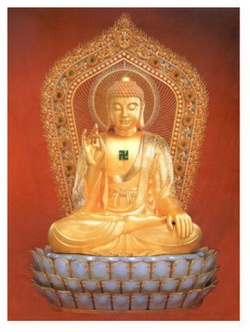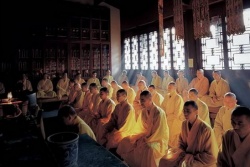Higher Realms
The uppermost realm on the Wheel of Rebirth is that of the devata. There are four highest devas or gods of which two, Indra and Brahma, appear most often in Buddhist scriptures where Indra, ruler of the upper realm, is called Shakra (Pali: Sakka.) In the orthodox Indian view, Brahma is the Intelligence that can be compared to the deity of the western religions, but he does not have that role in Buddhism. Shiva (in Tibetan, Lha Chen) also plays an important role; in fact his god-realm is called Shambhala.
In the Buddhist view, these gods and goddesses are, for the most part, considered to be highly evolved bodhisattvas.
The gods are waited upon by apsaras -- beautiful attendants and messengers, and gandharvas -- heavenly dancers and musicians. (The dakini can be included in both these categories.)
Indian mythology makes some distinction between rakshasas -- titans or the anti-gods -- and yakshas that are nature spirits, often tricksters. The former seek to usurp the powers of the gods or devas but the word rakshasa is also often translated ogre (Skt. ugra) or demon. Sometimes there seems to be no clear distinction between the two categories, and there are considered to be various types of both.
Tibetan tradition, Buddhist or not, has a large variety of these kinds of beings. A distinction is made between the deities and the local or worldly spirits. The former are objects of Refuge, while the latter may be considered as protectors but not usually sources of Refuge. Often they are propitiated in return for services rendered. In Buddhism, this custom stems from:
". . . the ninth century when the Tibetan king, Trisong Deutsen, invited Shantarakshita from India to teach Buddhism in Tibet. The local spirits proved hostile to this foreign religion and actively obstructed the efforts of the Indian spiritual master. Shantarakshita then advised the Tibetan king to invite Guru Padmasambhava, a tantric adept from India, to deal with these hostile spirits. Accordingly, Padmasambhava (also known as Guru Rinpoche) came to Tibet and subdued the most powerful spirits. Once vanquished, the spirits were bound by oath to act as Dharma Protectors . Thus, worldly protectors began to play a role in the Tibetan Buddhist pantheon.
One day, before the king and his ministers, Padmasambhava summoned one of the Four Great Kings, (the protectors of the four directions often depicted around the doors of Tibetan temples) into the body of a young man. Using the youth's body as a medium, the clairvoyant deity identified the spirits who were creating trouble. The deity pronounced that the spirit Thangla was responsible for the lightning strike on Marpori (the Red Hill that became the site of the Potala Palace) and that the spirit Yarla Shampo had provoked the flood which washed away the Phangthang Palace. This was the first occasion in Tibet in which a worldly deity was summoned into the body of a human being, . . . ." ~ Tibet.com
Vajra Sadhu (Dorje Lekpa,) a Genyen subdued by Padmasambhava.
Regarded in Buddhism as 8 types of impure manifestation of consciousness, they are:
hla [or lha] devas
ging attendants, musicians and dancers
sadag [genii, titans or guardians of 'upper' realms ],
Maras: creators of obstacles,
Klesha who embodies passion,
Yama who is death,
Skandha who is war,
Rahula Ganapati, the Godly Son," who is adversity or obstacle
tsen earth-spirits
nyen or rakshasa elementals, demons
mamo ogres
lu or nagas
These same Eight Groups -- the Hachi Bushu -- according to Japanese tradition.


